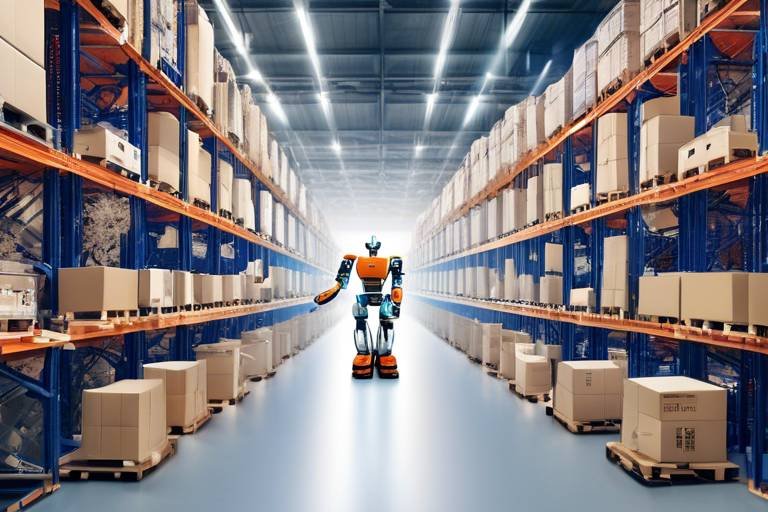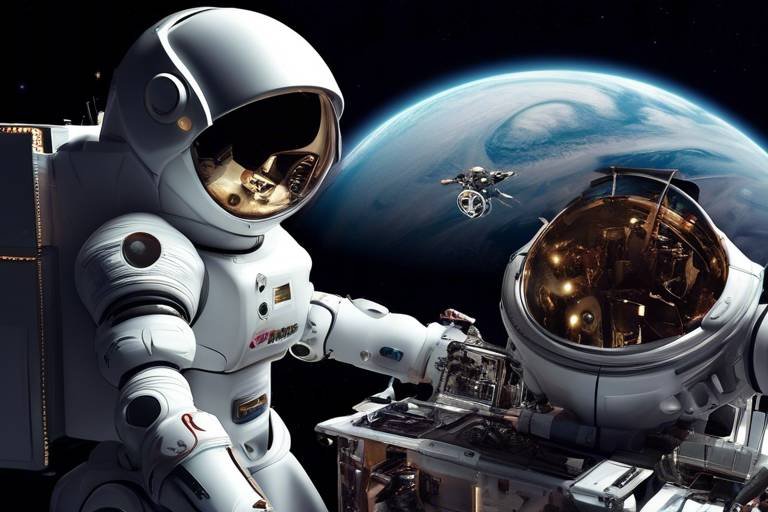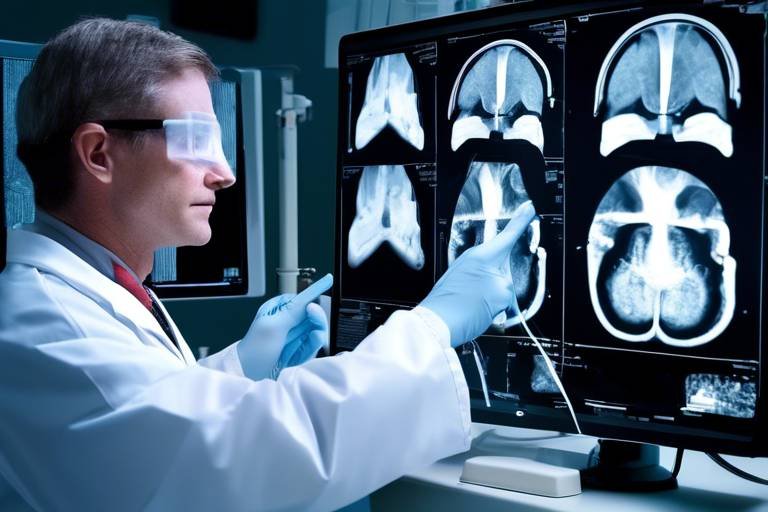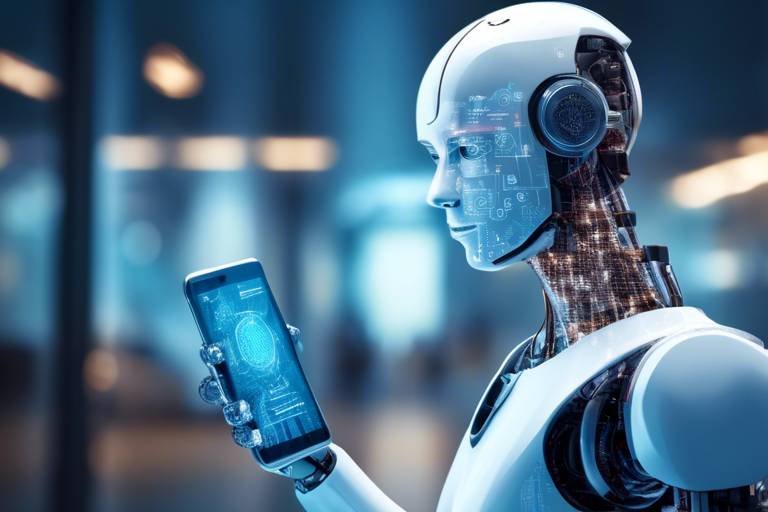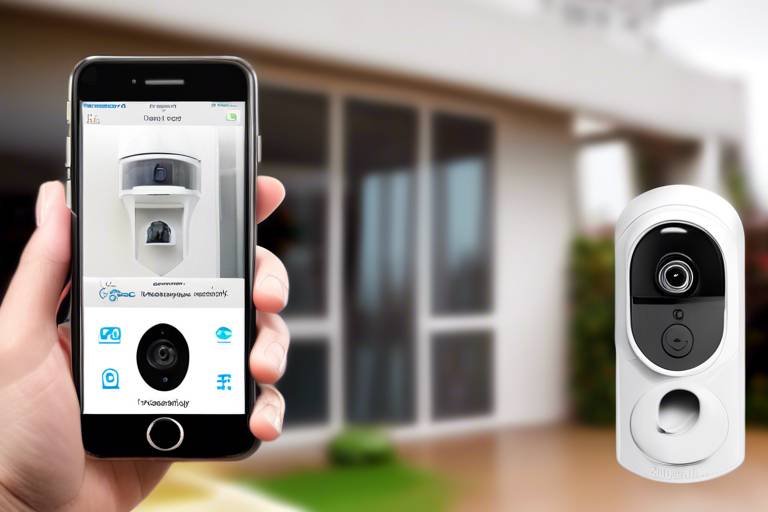How Robotics is Enhancing Human Abilities
In today's fast-paced world, the intersection of robotics and human capabilities is nothing short of revolutionary. Robotics is not just about machines taking over tasks; it's about enhancing our abilities and improving our quality of life. Imagine a world where robots assist us in ways that amplify our strengths, making the impossible possible. This article dives deep into the transformative impact of robotics across various fields, from healthcare to manufacturing, and how these advancements are integrating with artificial intelligence (AI) to create a future where humans and machines work hand in hand.
Medical robotics have truly revolutionized the landscape of healthcare. With the introduction of robotic-assisted surgeries, healthcare professionals can now perform procedures with unprecedented precision. These minimally invasive techniques not only reduce recovery time but also minimize the risks associated with traditional surgeries. Imagine a surgeon operating with robotic arms that provide enhanced dexterity and control—it's like having a superpower in the operating room! Furthermore, robotic rehabilitation technologies are helping patients regain mobility faster and more effectively than ever before. The potential for improved patient outcomes is staggering, as robots assist in physical therapy and rehabilitation, allowing for personalized and adaptive care.
The manufacturing sector has seen a seismic shift with the integration of robotics into production processes. Robots are now capable of performing tasks that were once deemed too dangerous or tedious for humans. This not only increases efficiency and productivity but also significantly reduces the likelihood of human error. Imagine a factory floor where robots are tirelessly assembling products while humans oversee the process, ensuring quality and innovation. This collaboration has led to a safer work environment and increased job satisfaction, as workers can focus on more complex and creative tasks.
One of the most exciting developments in manufacturing is the rise of collaborative robots, or cobots. Unlike traditional robots, cobots are designed to work alongside humans, enhancing productivity without replacing the human touch. Their built-in safety features allow them to operate in close proximity to workers, creating a seamless integration of human intelligence and machine efficiency. The result? A factory floor buzzing with productivity, where humans and robots collaborate to achieve remarkable outcomes.
The introduction of cobots is reshaping workforce dynamics in profound ways. As these machines take on repetitive and physically demanding tasks, workers are encouraged to adapt to new roles that require critical thinking and creativity. This shift necessitates robust training programs to equip employees with the skills needed to thrive in this new environment. Companies that invest in upskilling their workforce are not just enhancing productivity; they are fostering a culture of innovation and adaptability.
Real-world applications of cobots are vast and varied. From the automotive industry, where they assist in assembly lines, to electronics manufacturing, where precision is key, cobots are proving their versatility. Their ability to handle diverse tasks demonstrates the potential for enhanced collaboration between humans and machines, paving the way for a future where both can coexist harmoniously.
The integration of artificial intelligence into robotics is another game-changer. AI empowers robots to learn from their environments, adapt to new situations, and make informed decisions. This level of intelligence allows robots to assist humans more effectively, whether it's in a factory setting or at home. Picture a robot that can anticipate your needs based on your habits—it's like having a personal assistant that knows you better than anyone else!
As robotics technology continues to advance, these machines are becoming an integral part of our daily lives. From household chores to personal assistance, robots are designed to improve convenience and efficiency, freeing us up to focus on what truly matters. Imagine a world where your home is managed by smart devices that handle everything from cleaning to security—sounds like something out of a sci-fi movie, right? But it's becoming a reality!
Home automation systems are at the forefront of this robotic revolution. These systems utilize robotics to streamline daily routines, allowing smart devices to manage tasks such as cleaning, security, and energy consumption. With a simple voice command or a tap on your smartphone, you can control your entire home, enhancing both comfort and efficiency.
Assistive robotics is making a significant impact on the lives of the elderly, promoting independence and safety. These robots can assist with daily activities, medication management, and even provide companionship. By significantly improving the quality of life for seniors, assistive robots are not just machines; they are companions that help bridge the gap between loneliness and connection.
- What are the main benefits of robotics in healthcare? Robotics in healthcare enhance precision, reduce recovery times, and improve patient outcomes.
- How do collaborative robots differ from traditional robots? Collaborative robots are designed to work alongside humans, prioritizing safety and enhancing productivity without replacing human jobs.
- Can robots really improve daily life? Absolutely! Robots are increasingly integrated into home automation and assistive technologies, making everyday tasks easier and promoting independence.

Advancements in Medical Robotics
Medical robotics have truly transformed the landscape of healthcare, introducing a level of precision and efficiency that was once thought impossible. Imagine a surgeon operating with the steadiness of a machine, where every incision is calculated to perfection. This is not a distant dream; it’s happening right now, thanks to advancements in robotic-assisted surgery. These sophisticated machines allow for minimally invasive procedures, which means smaller incisions, reduced recovery times, and less pain for patients. The integration of robotic technology in the operating room has not only enhanced the capabilities of healthcare professionals but has also significantly improved patient outcomes.
One of the most notable innovations in medical robotics is the da Vinci Surgical System. This advanced robotic surgical system allows surgeons to perform complex procedures with enhanced vision and precision. With its 3D high-definition vision system and tiny instruments, the da Vinci system enables surgeons to operate through small incisions, leading to quicker recovery times and less post-operative discomfort. In fact, studies have shown that patients who undergo robotic-assisted surgeries often experience less blood loss and shorter hospital stays compared to traditional surgical methods.
Furthermore, the field of rehabilitation has also benefited immensely from robotics. Robotic exoskeletons are now being used to assist patients with mobility impairments, helping them regain movement and independence. These devices can be tailored to fit individual needs, allowing for personalized rehabilitation programs that adapt as the patient progresses. For instance, patients recovering from strokes or spinal cord injuries can utilize these robotic systems to relearn how to walk, providing them with the support and motivation they need to succeed.
| Key Benefits of Medical Robotics | Impact on Patient Care |
|---|---|
| Minimally Invasive Procedures | Reduced recovery time and less pain |
| Enhanced Precision | Lower risk of complications during surgery |
| Robotic Rehabilitation | Improved mobility and independence for patients |
As we look to the future, the integration of artificial intelligence in medical robotics promises even more groundbreaking advancements. Imagine robots that can learn from their interactions with patients and adapt their techniques to improve surgical outcomes. This potential for AI to enhance decision-making and adaptability in medical robotics is nothing short of revolutionary.
In conclusion, the advancements in medical robotics are not merely technical upgrades; they represent a profound shift in how healthcare is delivered. With the ability to enhance surgical precision, improve rehabilitation outcomes, and personalize patient care, robotics are significantly elevating the quality of life for patients around the world. The marriage of technology and medicine is just beginning, and the possibilities are as exciting as they are limitless.
- What are medical robots used for?
Medical robots are used for various applications, including robotic-assisted surgery, rehabilitation, and assisting healthcare professionals in diagnostics and treatment. - How do robotic surgeries differ from traditional surgeries?
Robotic surgeries are minimally invasive, allowing for smaller incisions, greater precision, and quicker recovery times compared to traditional open surgeries. - Are robotic surgeries safe?
Yes, robotic surgeries are generally safe and have been shown to reduce complications and improve recovery times, although every surgery carries inherent risks.

Robotics in Manufacturing
Robotics has become a cornerstone of modern manufacturing, transforming traditional processes into highly efficient, automated systems. The integration of robotic technology has not only increased productivity but has also significantly enhanced the **quality** of products. Imagine a factory floor where machines work tirelessly, performing tasks with precision that humans simply cannot match. This is the reality of today's manufacturing landscape, where robots are the unsung heroes of industry.
One of the most striking benefits of robotics in manufacturing is the **reduction of human error**. With robots handling repetitive tasks, the likelihood of mistakes diminishes, leading to higher quality outputs and less waste. For example, in automobile production, robotic arms are used for welding and painting, ensuring that every vehicle meets stringent safety and aesthetic standards. This level of accuracy not only saves time but also enhances the company's reputation among consumers.
Moreover, the **safety** of workers has drastically improved due to robotic automation. Dangerous tasks that previously posed risks to human workers, such as lifting heavy materials or operating hazardous machinery, are now performed by robots. This shift not only protects employees but also boosts morale, as workers can focus on more complex and rewarding tasks. The integration of robotics is akin to having a safety net that allows human workers to thrive in a safer environment.
Among the various types of robots deployed in manufacturing, **collaborative robots**, or cobots, stand out for their ability to work alongside humans. These robots are designed with safety features that allow them to operate in close proximity to human workers without the need for safety cages. This collaboration leads to a more efficient workflow, as cobots can handle monotonous tasks while humans concentrate on more intricate processes that require creativity and critical thinking.
For instance, in an electronics manufacturing plant, cobots can assist in assembling components, allowing human workers to focus on quality control and problem-solving. This partnership not only increases productivity but also fosters a sense of teamwork between humans and machines, creating a dynamic work environment that is both innovative and efficient.
The introduction of robotics, particularly cobots, has significantly altered workforce dynamics. As these machines take on more tasks, workers are required to adapt to new roles and responsibilities. This shift means that companies must invest in **training programs** to equip their employees with the skills necessary to work effectively alongside these advanced machines. Just as a musician learns to play with a new instrument, workers must learn how to integrate robotics into their daily routines.
Organizations that embrace this change often see a boost in employee satisfaction. Workers feel empowered when they can leverage technology to enhance their performance. In fact, many companies report that their employees enjoy the challenge of learning new skills and appreciate the opportunity to work with cutting-edge technology.
The versatility of robotics in manufacturing is evident in its wide range of real-world applications. From the automotive industry to electronics and even food production, robots are making waves across various sectors. For example, in the automotive industry, robots are utilized for tasks such as:
- Welding components together
- Painting vehicles
- Assembling parts with precision
In electronics manufacturing, robots handle the intricate assembly of circuit boards, ensuring that each component is placed accurately. In food production, robots are used for packaging and quality inspection, ensuring that products are safe and meet regulatory standards. This adaptability demonstrates the potential for enhanced collaboration between humans and machines, paving the way for a future where technology and human skills complement each other seamlessly.
In conclusion, the integration of robotics in manufacturing is not just a trend; it is a **revolution** that is reshaping the industry. As companies continue to adopt these technologies, the focus will shift toward maximizing the synergy between human workers and robots, ultimately leading to a more efficient, safe, and productive manufacturing environment.
1. How do robots improve efficiency in manufacturing?
Robots improve efficiency by performing repetitive tasks faster and more accurately than humans, reducing downtime and increasing production rates.
2. Are collaborative robots safe to work with?
Yes, collaborative robots are designed with safety features that allow them to work alongside humans without posing a danger, making them ideal for shared workspaces.
3. What skills do workers need to operate alongside robots?
Workers need to develop skills in technology operation, programming, and problem-solving to effectively collaborate with robots in the manufacturing process.
4. What industries benefit the most from robotics?
Industries such as automotive, electronics, and food production benefit significantly from robotics due to the precision, efficiency, and safety improvements they offer.
5. Will robots replace human jobs in manufacturing?
While robots will take over certain tasks, they will also create new job opportunities that require human oversight, programming, and maintenance, leading to a shift rather than a complete replacement.

Collaborative Robots (Cobots)
In the modern manufacturing landscape, collaborative robots, affectionately known as cobots, are transforming the way we think about human-machine interaction. Unlike traditional robots that operate in isolation, cobots are designed to work side by side with human workers, enhancing productivity while ensuring safety. Imagine a bustling factory floor where a robot gently assists a worker in assembling components, almost like a dance partner—this is the essence of cobots. Their unique design prioritizes safety and efficiency, allowing them to seamlessly integrate into existing workflows without the need for extensive safety barriers.
The beauty of cobots lies in their versatility. They can be programmed to perform a variety of tasks, ranging from heavy lifting to intricate assembly. This adaptability not only boosts productivity but also allows human workers to focus on more complex and creative tasks. For instance, a cobot might handle repetitive tasks such as screwing or packaging, freeing up human employees to engage in quality control or innovative problem-solving. The result? A more efficient production line where both humans and robots thrive.
However, introducing cobots into the workforce isn't just about the technology; it's about changing mindsets. Workers need to embrace these machines as partners rather than competitors. Training programs are vital to equip employees with the necessary skills to collaborate effectively with cobots. Understanding how to communicate and work alongside these machines can lead to a more harmonious and productive work environment. Companies that invest in such training often see a significant return on investment, not only in terms of productivity but also in employee satisfaction.
To illustrate the impact of cobots in various industries, consider the following table that highlights some real-world applications:
| Industry | Application | Benefit |
|---|---|---|
| Automotive | Assembly line assistance | Increased speed and precision |
| Electronics | Component placement | Reduced error rates |
| Food & Beverage | Packing and sorting | Enhanced hygiene and efficiency |
In summary, cobots are not just a technological advancement; they represent a shift in how we approach work. By fostering an environment where humans and robots collaborate, industries can unlock new levels of productivity and innovation. As we continue to embrace this new era of manufacturing, the potential for cobots to enhance our capabilities is truly exciting.
- What are cobots? Cobots are collaborative robots designed to work alongside humans in a shared workspace.
- How do cobots improve safety? Cobots are equipped with sensors and safety features that allow them to operate safely around human workers.
- Can cobots be programmed for different tasks? Yes, cobots can be easily reprogrammed to perform a variety of tasks, making them versatile tools in manufacturing.
- What industries benefit from cobots? Cobots are used in various industries, including automotive, electronics, and food & beverage, among others.
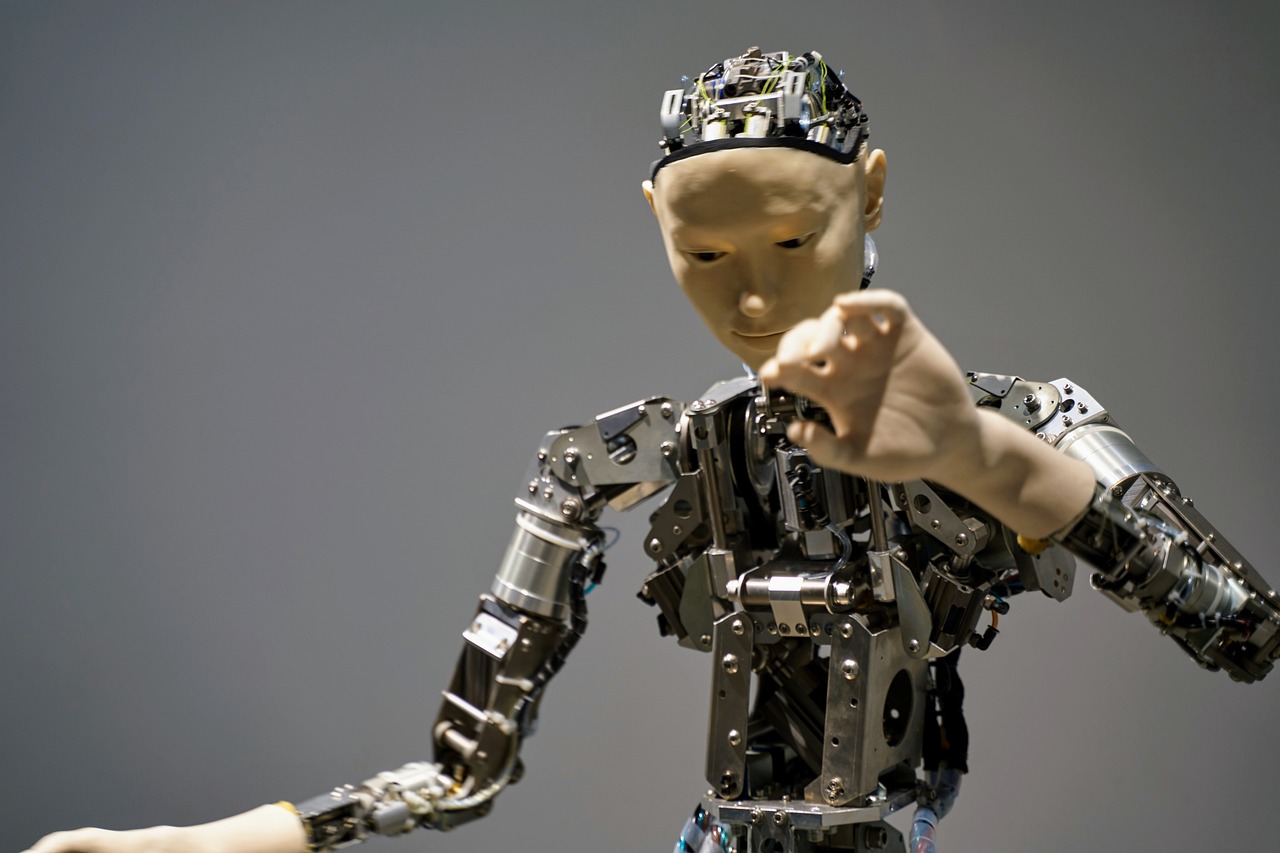
Impact on Workforce Dynamics
The introduction of collaborative robots, or cobots, into manufacturing environments is not just a technological advancement; it’s a seismic shift in the very fabric of workforce dynamics. Imagine walking into a factory where machines are not just tools but active participants in the production process, working side by side with human workers. This integration fosters a new era of collaboration, but it also brings with it a host of changes that require adaptation and learning.
As cobots take on repetitive and hazardous tasks, the roles of human workers are evolving. Workers are transitioning from manual labor to more complex roles that require critical thinking, creativity, and problem-solving skills. This shift can be daunting, but it also opens up exciting opportunities for personal and professional growth. Training programs become essential as companies seek to equip their employees with the skills necessary to thrive in this new environment. These programs often focus on:
- Understanding how to operate and interact with cobots
- Developing skills in programming and maintenance
- Enhancing soft skills such as teamwork and communication
Furthermore, the adoption of cobots can lead to a more fulfilling work environment. By taking over mundane tasks, cobots allow human workers to focus on more engaging and meaningful work. This not only increases job satisfaction but can also lead to higher productivity levels. In fact, studies have shown that when workers feel valued and are engaged in their tasks, the overall efficiency of the workplace improves significantly.
However, this transformation is not without its challenges. The fear of job displacement is a common concern among workers. It's crucial for organizations to communicate transparently about how cobots will augment rather than replace human roles. In many cases, cobots can take on the more dangerous and strenuous tasks, allowing human workers to engage in more strategic decision-making processes. This symbiotic relationship can redefine job roles and enhance the overall productivity of the workforce.
As we look to the future, the impact of cobots on workforce dynamics will continue to evolve. The key to a successful transition lies in embracing change and fostering a culture of continuous learning. Companies that invest in their workforce will not only enhance productivity but will also cultivate a loyal and skilled team ready to tackle the challenges of tomorrow.
- What are collaborative robots (cobots)?
Cobots are robots designed to work alongside humans, enhancing productivity and safety in various tasks. - Will cobots replace human jobs?
While cobots may take over repetitive tasks, they are designed to augment human capabilities and create new roles that require more complex skills. - How can workers prepare for changes brought by cobots?
Workers can prepare by engaging in training programs that focus on operating, programming, and maintaining cobots, as well as enhancing their soft skills.
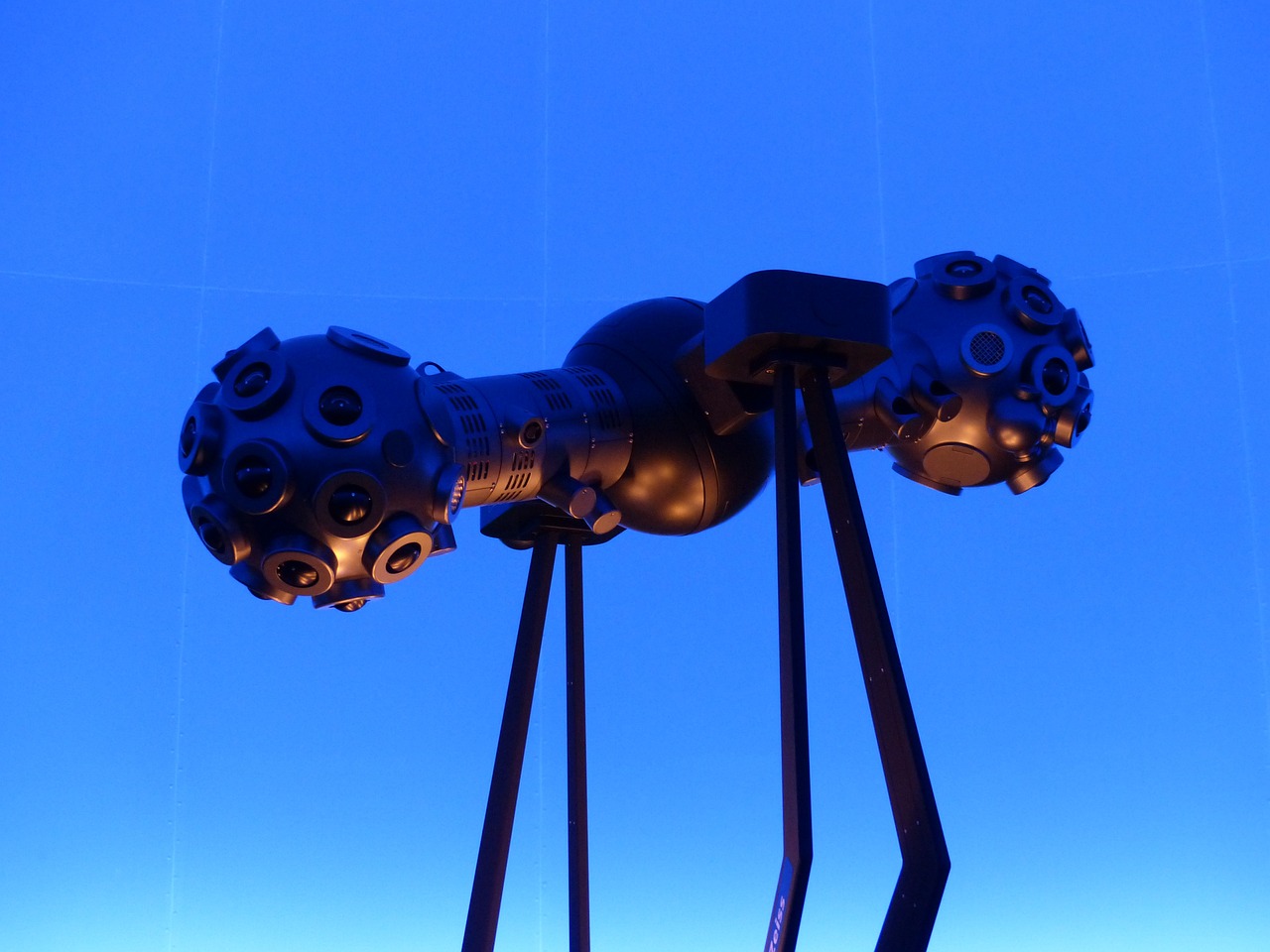
Real-World Applications
The integration of collaborative robots, or cobots, into various industries has sparked a wave of innovation and efficiency that’s hard to ignore. Imagine walking into an automotive factory where robots are not just working on the assembly line alone but are actually teaming up with human workers to assemble vehicles. This partnership allows for a level of precision and speed that was previously unimaginable. For example, in the automotive sector, cobots are frequently used for tasks such as welding, painting, and even quality inspections. Their ability to work side by side with humans ensures that production lines are not only faster but also safer.
But it's not just the automotive industry that benefits from cobots. In electronics manufacturing, these robots assist in assembling delicate components, where human dexterity combined with robotic precision leads to fewer errors and higher quality products. This synergy between humans and robots is a game-changer, making it possible to meet high demand without sacrificing quality. In fact, a recent study indicated that companies using cobots saw a 20% increase in production efficiency while also reducing the rate of defects by up to 30%.
In the realm of logistics, cobots are transforming how goods are stored, sorted, and shipped. Picture a bustling warehouse where robots are zipping around, picking up items and delivering them to human workers who then package and ship them. This dynamic not only speeds up the process but also allows for a more organized and efficient workspace. Companies like Amazon are already utilizing this technology to enhance their fulfillment centers, showcasing a practical application of cobots that can handle repetitive tasks while freeing up human workers for more complex roles.
Furthermore, the food and beverage industry has also embraced cobots for tasks such as packaging and palletizing. These robots ensure consistency and speed, which is crucial in an industry where timing and quality are everything. With the ability to handle heavy lifting and repetitive motions, cobots reduce the physical strain on human workers, leading to a healthier workforce and lower injury rates.
As we look to the future, the potential applications of cobots seem limitless. From agriculture, where they could assist in planting and harvesting crops, to healthcare, where they might help with patient care and medication delivery, the possibilities are exciting. The key takeaway here is that cobots are not replacing human workers; rather, they are enhancing human capabilities, allowing us to focus on what we do best while leaving the repetitive and physically demanding tasks to our robotic counterparts.
- What are collaborative robots (cobots)?
Cobots are robots designed to work alongside humans in a shared workspace. They are built with safety features that allow them to operate without the need for safety cages, making them ideal for collaborative tasks.
- How do cobots improve productivity?
By automating repetitive tasks, cobots allow human workers to focus on more complex and value-added activities, leading to increased overall productivity and efficiency.
- Are cobots safe to work with?
Yes, cobots are equipped with advanced safety features that allow them to detect human presence and adjust their movements accordingly, ensuring a safe working environment.
- What industries are using cobots?
Cobots are being utilized in various industries, including automotive, electronics, logistics, food and beverage, and healthcare, among others.

AI Integration in Robotics
The integration of artificial intelligence (AI) into robotics is nothing short of a game-changer. Imagine a world where machines can not only perform tasks but also learn from their experiences and adapt to new situations. This is the reality we are stepping into, where robots equipped with AI are becoming increasingly capable of assisting humans in a variety of tasks. Whether it's in manufacturing, healthcare, or even at home, AI-enhanced robots are transforming how we interact with technology.
One of the most exciting aspects of AI integration is the ability for robots to process data and make decisions in real-time. For instance, in a manufacturing setting, a robot can analyze the workflow, identify bottlenecks, and adjust its actions accordingly to optimize efficiency. This level of adaptability not only improves productivity but also enhances the overall quality of the work being done. It's like having a co-worker who never tires and is always looking for ways to improve the process!
Moreover, the synergy between AI and robotics allows for a more human-like interaction. Robots can now understand natural language, recognize faces, and even interpret emotional cues. This capability is particularly beneficial in sectors like healthcare, where robots can assist doctors by providing real-time data analysis or even offering companionship to patients. The potential for robots to understand and respond to human emotions opens up new avenues for enhancing user experience and satisfaction.
To better illustrate the impact of AI integration in robotics, consider the following table that outlines key benefits:
| Benefit | Description |
|---|---|
| Improved Decision-Making | Robots can analyze vast amounts of data quickly, leading to informed decisions. |
| Increased Efficiency | AI enables robots to optimize processes and reduce downtime. |
| Enhanced User Interaction | Natural language processing allows for better communication between robots and humans. |
| Learning Capabilities | Robots can learn from their environment and experiences, adapting over time. |
As we delve deeper into the future, the potential applications of AI in robotics seem limitless. From smart factories where robots work alongside humans to personal assistants that help manage our daily lives, the integration of AI is set to redefine our relationship with technology. Imagine a robot that can anticipate your needs based on your daily habits or one that can assist in complex surgical procedures with unparalleled precision. The possibilities are not just exciting; they are transformative!
In conclusion, the integration of AI into robotics is not merely a technological advancement; it is a leap towards a future where machines and humans work together more effectively than ever before. As we continue to innovate and push the boundaries of what is possible, the collaboration between AI and robotics will undoubtedly enhance our capabilities and improve our quality of life.
- What are the primary benefits of AI in robotics?
The primary benefits include improved decision-making, increased efficiency, enhanced user interaction, and learning capabilities that allow robots to adapt over time.
- How does AI improve human-robot interaction?
AI enhances interaction by enabling robots to understand natural language, recognize faces, and interpret emotional cues, making them more relatable and responsive.
- Can AI robots work in healthcare?
Yes, AI robots can assist in healthcare by providing data analysis, supporting medical professionals, and offering companionship to patients.
- What is the future of AI in robotics?
The future is bright, with endless possibilities for AI-enhanced robots to improve efficiency and quality of life across various industries.

Robotics in Daily Life
In recent years, robotics has woven itself into the very fabric of our daily lives, transforming mundane tasks into seamless experiences. Imagine waking up in the morning, and before you even step out of bed, your smart home system has already brewed your coffee, adjusted the thermostat, and prepared your favorite morning playlist. This isn’t science fiction; it’s the reality of how robotics is enhancing our everyday routines, making life not just easier but also more enjoyable.
From household chores to personal assistance, the integration of robotics into our daily activities is all about convenience and efficiency. For instance, consider the rise of robotic vacuum cleaners. These little gadgets scuttle around your home, picking up dirt and debris while you relax or tackle more important tasks. They are equipped with sensors that help them navigate around furniture and avoid obstacles, ensuring your floors stay clean without you lifting a finger. This is just one example of how robotics is taking the hassle out of home maintenance.
But it's not just about cleaning; robotics is also making strides in security. Smart home security systems utilize robotic technology to monitor your property, providing peace of mind. With features like motion detection and real-time alerts sent directly to your smartphone, you can keep an eye on your home from anywhere in the world. This level of connectivity and control is empowering, allowing you to respond quickly to potential threats and enhancing your overall sense of safety.
Moreover, assistive robotics is a game-changer for the elderly. As our population ages, the need for support systems that promote independence has never been more critical. These robots are designed to help seniors with daily activities, such as reminding them to take their medications, assisting with mobility, and even providing companionship. The emotional and physical support these robots offer can significantly improve the quality of life for elderly individuals, allowing them to live with dignity and grace.
Let’s take a closer look at some of the key areas where robotics is making a difference in daily life:
- Home Automation: Smart devices can control lighting, heating, and even appliances, making your home more energy-efficient and comfortable.
- Health Monitoring: Wearable robots and health tech can track vital signs and alert users to potential health issues, fostering proactive health management.
- Personal Assistants: Voice-activated assistants can help with everything from setting reminders to answering questions, essentially acting as a digital companion.
As we look ahead, the potential for robotics in daily life seems limitless. With advancements in artificial intelligence and machine learning, robots are becoming smarter and more capable of understanding and adapting to our needs. Picture a future where your home learns your preferences and automatically adjusts to suit your lifestyle. This is not just a dream; it's a glimpse into the future of living with robotics.
| Question | Answer |
|---|---|
| How do robotic vacuum cleaners work? | Robotic vacuum cleaners use sensors and cameras to navigate around your home, identifying dirt and obstacles while mapping out the most efficient cleaning path. |
| Can assistive robots really help the elderly? | Yes, assistive robots provide support with daily tasks, medication reminders, and companionship, helping seniors maintain independence and improve their quality of life. |
| What are some examples of home automation? | Examples include smart thermostats, automated lighting systems, and voice-activated assistants that control various devices within your home. |
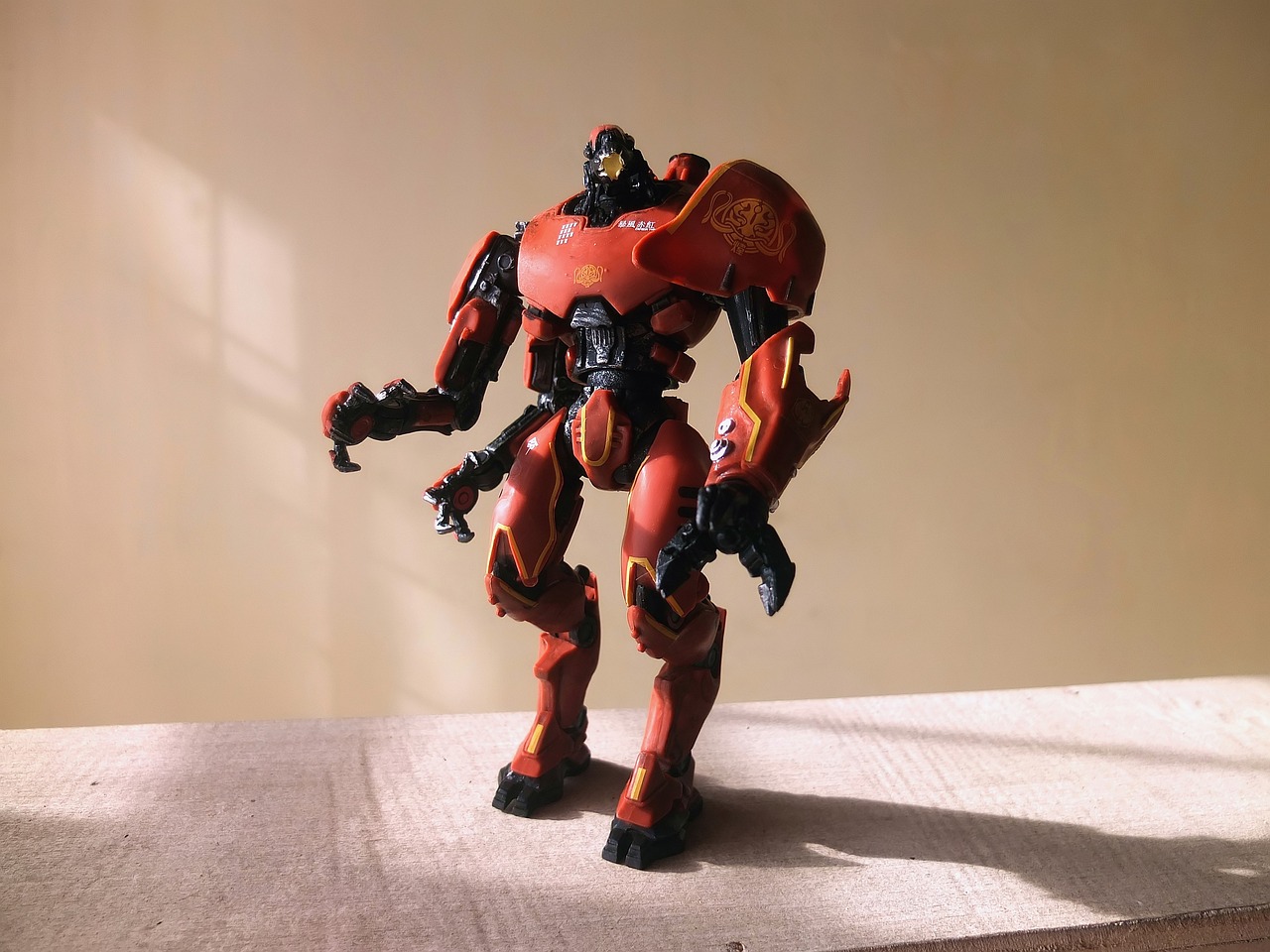
Home Automation Systems
Home automation systems are rapidly transforming the way we live, making our homes not just smarter but also significantly more efficient. Imagine waking up in the morning to the gentle glow of your smart lights gradually illuminating your room, while your coffee maker brews the perfect cup of coffee, all without you lifting a finger. This is the magic of robotics in home automation, where technology seamlessly integrates into our daily routines, enhancing comfort and convenience.
These systems utilize a network of interconnected devices that communicate with each other, allowing homeowners to control everything from lighting and heating to security and appliances through a single interface. With just a few taps on a smartphone or voice commands to a virtual assistant, you can adjust the thermostat, lock the doors, or even check the security cameras. The ease of use is a game changer, especially for busy individuals and families.
One of the most significant advantages of home automation is energy efficiency. Smart devices can learn your habits and adjust settings accordingly, helping you save on energy bills. For instance, smart thermostats can lower the temperature when you’re not home and raise it before you return, ensuring comfort without wasting energy. In fact, according to recent studies, homes equipped with automation systems can reduce energy consumption by up to 30%.
Moreover, home automation systems enhance security. With smart cameras and motion detectors, homeowners can monitor their property in real-time, receiving alerts on their smartphones if any unusual activity is detected. This level of vigilance not only provides peace of mind but also acts as a deterrent to potential intruders. The integration of robotics in security systems means that you can also automate responses, such as turning on lights or sounding alarms, when a breach is detected.
As we delve deeper into the realm of home automation, it's essential to consider the various components that make these systems work. Here’s a brief overview of the key elements:
| Component | Function |
|---|---|
| Smart Hub | Central control unit for all connected devices. |
| Smart Lights | Adjust brightness and color via app or voice commands. |
| Smart Thermostat | Regulates temperature based on your schedule and preferences. |
| Smart Security Cameras | Monitor home and send alerts for suspicious activities. |
| Smart Locks | Lock and unlock doors remotely, enhancing security. |
While the benefits of home automation are undeniable, it’s also essential to consider the potential challenges. Issues such as privacy concerns and reliance on technology can arise. However, with the right security measures in place, such as strong passwords and regular software updates, these concerns can be mitigated.
In conclusion, home automation systems represent a significant leap forward in how we interact with our living spaces. They not only provide unparalleled convenience but also contribute to energy savings and enhanced security. As technology continues to evolve, the possibilities for home automation are endless, paving the way for a future where our homes work smarter, allowing us to focus on what truly matters in life.
- What is home automation? Home automation refers to the control of home appliances and systems through a centralized interface, allowing for remote management and automation of tasks.
- How does home automation improve energy efficiency? Smart devices can learn user habits and optimize settings to reduce energy consumption, leading to lower energy bills.
- Are home automation systems secure? While there are potential security risks, implementing strong passwords and regular updates can significantly enhance the security of these systems.
- Can I control my home automation system remotely? Yes, most home automation systems allow for remote access via smartphone apps, enabling control from anywhere.
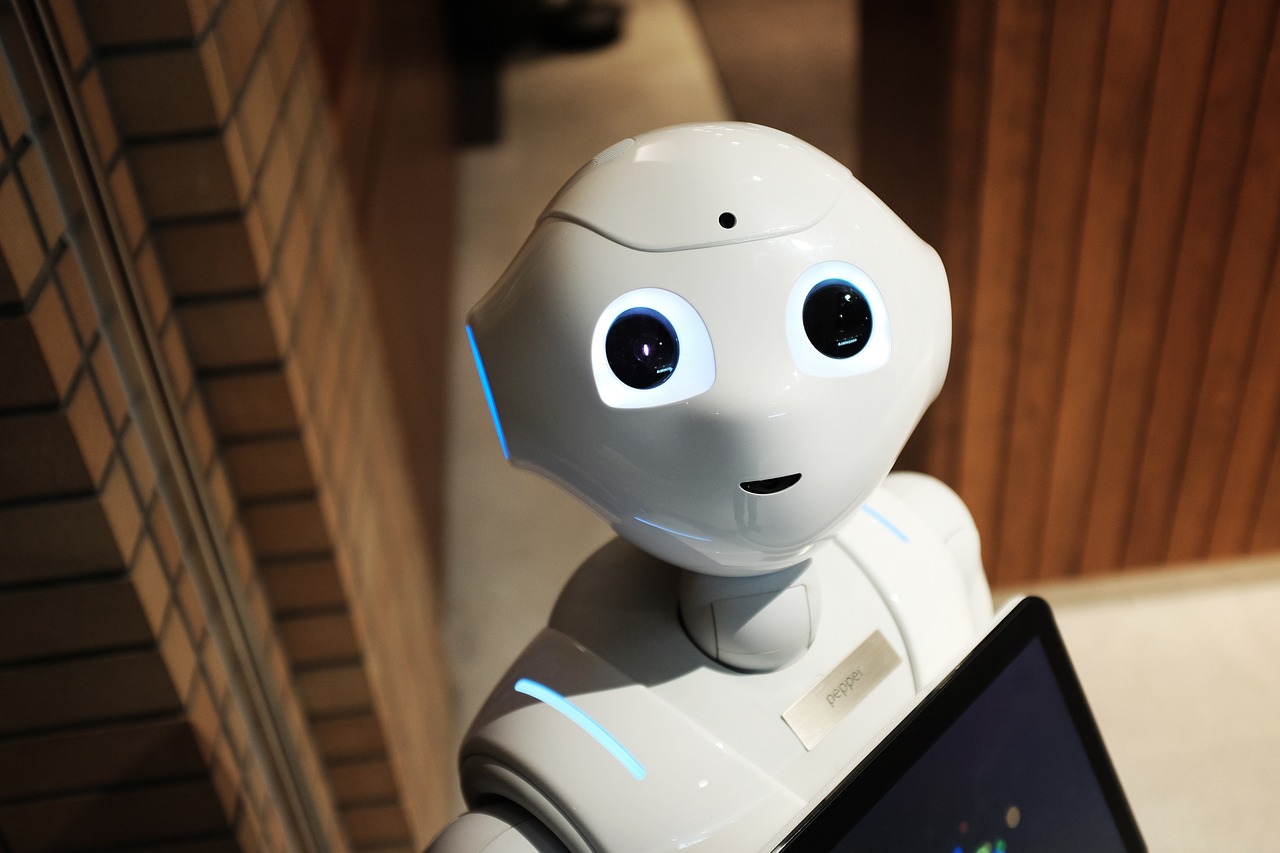
Assistive Robotics for the Elderly
As our population ages, the need for innovative solutions to support the elderly becomes increasingly critical. Assistive robotics has emerged as a beacon of hope, offering a range of functionalities that empower seniors to maintain their independence while ensuring their safety. Imagine a world where technology acts as a companion, not just a tool—this is the reality that assistive robots are creating. These robots are designed to assist with daily activities, provide companionship, and even monitor health, ultimately enhancing the quality of life for older adults.
One of the most significant benefits of assistive robotics is their ability to help seniors with daily tasks that may become challenging due to age-related limitations. For instance, robots can assist with:
- Medication management, reminding seniors when to take their pills
- Mobility assistance, helping them move safely around their homes
- Household chores, such as cleaning and laundry
- Emergency response, alerting caregivers or medical professionals when needed
These robots are not just functional; they are also designed with the user experience in mind. Many assistive robots come equipped with intuitive interfaces that make them easy to use for individuals who may not be tech-savvy. Some models even feature voice recognition, allowing seniors to interact with them naturally, almost as if they were conversing with a friend. This human-robot interaction is crucial, as it helps reduce feelings of loneliness and isolation, which are common among the elderly.
Moreover, assistive robotics can provide invaluable support in monitoring health and safety. Many of these robots are equipped with sensors that can track vital signs, detect falls, and even analyze daily activity patterns. This data can be shared with family members or healthcare providers, ensuring that seniors receive timely assistance if needed. For example, if a robot detects a fall, it can immediately alert emergency services, potentially saving a life. The integration of such technology not only enhances safety but also provides peace of mind for both seniors and their families.
In addition to practical assistance, these robots can also serve as companions, engaging in conversation and providing emotional support. Studies have shown that social interaction is essential for mental health, and assistive robots can help bridge the gap when human interaction is limited. Imagine a robot that can play games, tell stories, or simply engage in conversation—this companionship can significantly improve the emotional well-being of elderly individuals.
As we look to the future, the potential for assistive robotics in enhancing the lives of seniors is boundless. Companies are continuously innovating, developing robots that are not only more capable but also more affordable. The goal is to make these technologies accessible to as many people as possible, ensuring that everyone can benefit from the advancements in robotics.
In conclusion, assistive robotics represents a transformative shift in how we care for the elderly. By combining technology with compassion, we can create solutions that empower older adults to live fulfilling, independent lives. As we embrace these innovations, we must continue to focus on their integration into everyday life, ensuring that our seniors receive the support they need while enjoying the benefits of companionship and safety.
1. What types of tasks can assistive robots perform for the elderly?
Assistive robots can help with medication management, mobility assistance, household chores, and emergency response. They are designed to support daily activities and enhance safety.
2. Are assistive robots easy to use for seniors?
Yes, most assistive robots come with user-friendly interfaces and voice recognition capabilities, making them accessible for individuals who may not be tech-savvy.
3. How do assistive robots monitor health and safety?
Many assistive robots are equipped with sensors to track vital signs, detect falls, and analyze daily activity patterns. They can alert caregivers or medical professionals if any concerning issues arise.
4. Can assistive robots provide companionship?
Absolutely! Assistive robots can engage in conversation, play games, and provide emotional support, helping to reduce feelings of loneliness and isolation among seniors.
Frequently Asked Questions
- What are the main benefits of robotics in healthcare?
Robotics in healthcare offers numerous benefits, including enhanced precision during surgeries, reduced recovery times for patients, and the ability to perform minimally invasive procedures. These advancements not only improve patient outcomes but also allow healthcare professionals to focus on more complex tasks, ultimately leading to a higher quality of care.
- How do collaborative robots (cobots) differ from traditional robots?
Collaborative robots, or cobots, are designed to work alongside humans safely and efficiently. Unlike traditional robots that often operate in isolation, cobots can interact with human workers, sharing tasks and enhancing productivity on the factory floor. Their design prioritizes safety features, making them ideal for environments where human-robot collaboration is essential.
- What role does artificial intelligence play in robotics?
Artificial intelligence (AI) significantly enhances robotics by enabling machines to learn from their surroundings and make informed decisions. This integration allows robots to adapt to new tasks and environments, improving their ability to assist humans effectively. AI-driven robots can analyze data in real-time, leading to more efficient operations across various industries.
- Can robotics improve daily life for individuals?
Absolutely! Robotics are increasingly integrated into our daily routines through home automation systems and assistive technologies. From managing household chores to providing support for the elderly, these advancements enhance convenience and efficiency, allowing individuals to focus on more meaningful activities while enjoying a higher quality of life.
- What are some real-world applications of robotics in manufacturing?
Robotics in manufacturing has transformed various industries by automating repetitive tasks, improving quality control, and increasing overall production efficiency. Real-world applications include assembly line work, packaging, and quality inspection, where robots work alongside human operators to streamline processes and minimize errors.
- How do assistive robots help the elderly?
Assistive robots play a crucial role in supporting the elderly by helping them with daily tasks such as medication management, mobility assistance, and even companionship. These robots promote independence and safety, allowing seniors to maintain a higher quality of life while reducing the burden on caregivers.



